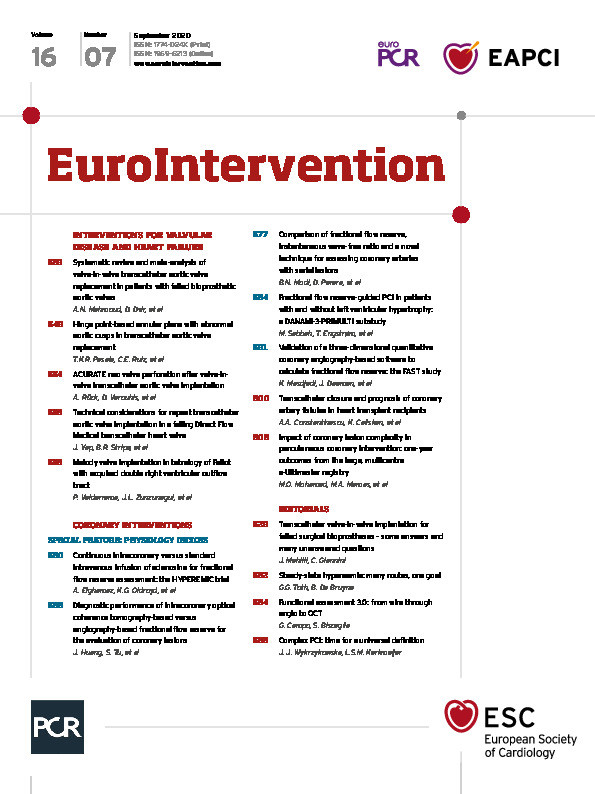
Percutaneous coronary intervention (PCI) has undergone rapid evolution over the last 40 years and is currently a safe and effective therapeutic option for patients with coronary artery disease (CAD) worldwide. Initially, PCI was performed in relatively young and stable patients receiving a single intracoronary stent; however, due to the introduction of drug-eluting stents (DES), along with improvements in implantation techniques and adjunct pharmacological therapy, patients with more comorbidities and/or lesions that are more complex are now treated with PCI. However, certain patients and lesion subsets present unique challenges to the interventional cardiologist and are still associated with technical difficulties, periprocedural complications and high rates of restenosis. Currently, approximately 30% of PCIs are considered complex PCIs. Despite this shift in expanding the applicability of PCI, the underlying determinants and impact of PCI complexity on clinical outcomes remain poorly characterised.
In this issue of EuroIntervention, Mohamed et al report the results of a post hoc subgroup analysis from the e-Ultimaster registry exploring the impact of lesion complexity on one-year clinical outcomes after implantation of the Ultimaster® DES (Terumo Corp., Tokyo, Japan).
The e-Ultimaster registry involves 35,839 patients with one-year follow-up. The authors defined complex PCI as multivessel PCI, procedures requiring at least three stents, involving at least three lesions or a bifurcation requiring two stents, use of total stent length greater than 60 mm, or chronic total occlusion (CTO) PCI (n=9,793; 27.3%). One-year rates of cardiac death, target vessel myocardial infarction or target lesion revascularisation were significantly higher among patients with versus those without complex PCI features (adjusted HR 1.41 [1.25-1.59]). Every individual complex feature other than CTO was associated with higher risk of adverse events. The risk increased in a graded manner with the number of complex PCI features. The greatest hazard was observed in bifurcation lesions treated with a two-stent strategy.
This report of Mohamed et al1 might be a good step towards a universal definition of complex PCI. Different definitions of complex PCI are used in clinical studies, making it difficult to compare and generate conclusions. In addition, the heterogeneity of the definition complicates individualised, risk-based decision making that is increasingly emphasised in clinical practice guidelines. Mohamed et al use simple and objective features to define the complexity of PCI. They show that all these features, except for CTOs, are associated with an increased ischaemic risk. Moreover, the more features, the higher the ischaemic risk. Besides the increased ischaemic risk, complex features also increased the risk of major bleeding. Characterising determinants of PCI complexity, its impact and formulating a universal definition might be even more relevant now, given the recent emphasis on shortening the duration of dual antiplatelet therapy (DAPT) and switching to potent P2Y12-inhibitor monotherapy. Giustino et al showed that, in complex PCI, using the same definition as Mohamed et al, 12-month DAPT yielded a significant reduction in ischaemic risk compared to short-term DAPT (3 or 6 months)2. Moreover, the benefit of 12-month DAPT increased in a graded manner with the number of complex PCI features2. A sub-analysis of the GLOBAL LEADERS trial demonstrated a decrease of ischaemic risk without increasing bleeding events of the experimental antiplatelet regimen with ticagrelor monotherapy compared with 12-month DAPT in complex PCI3. They used a similar definition of complex PCI. The group of Mehran performed a subgroup analysis of the TWILIGHT study evaluating ticagrelor monotherapy in complex PCI4. They demonstrated a decrease in bleeding but a similar ischaemic risk. The population differed from the GLOBAL LEADERS trial in that it included only high bleeding risk patients. In addition, TWILIGHT used a different definition of complex PCI4.
Translating these results into clinically meaningful implications, however, requires further clarity on the definition of complex PCI procedures. The findings of Mohamed et al reinforce the importance of procedural factors as determinants of risk after PCI. Standardised criteria that are collected uniformly across all studies are needed and would allow a more quantitative and reliable estimate of procedural complexity and risks, as well as the long-term outcomes.
Conflict of interest statement
The authors have no conflicts of interest to declare.
Supplementary data
To read the full content of this article, please download the PDF.

